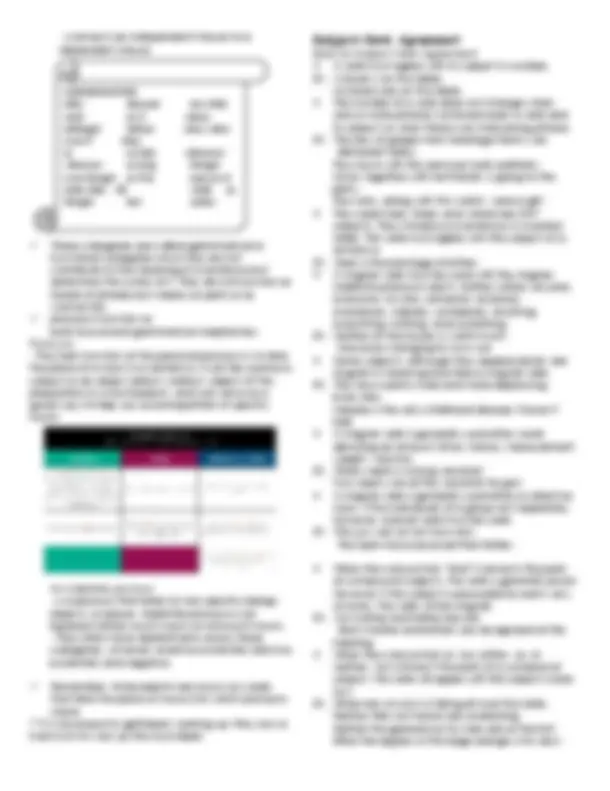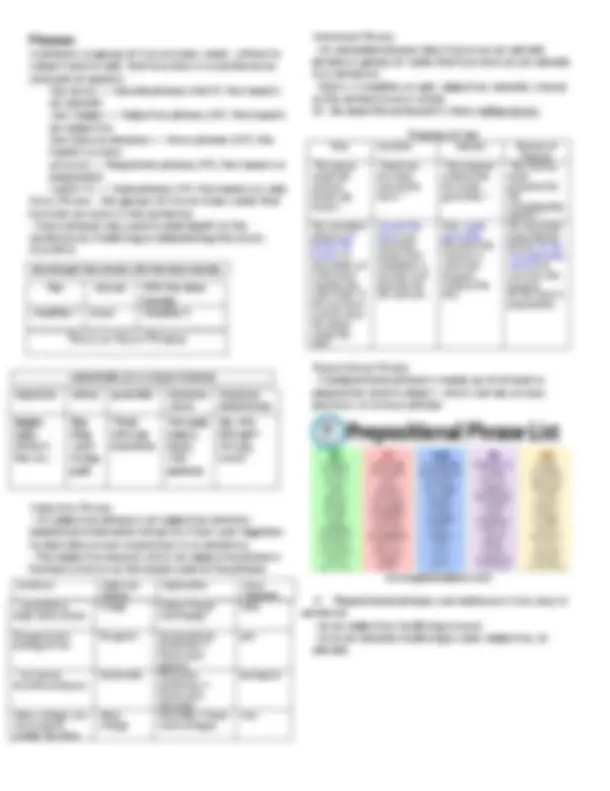Download Reviewer in university subject and more Summaries Medical Genetics in PDF only on Docsity!
Grammar & Our Knowledge of Language
Syntax - basic arrangement of words in sentences/word class --- part of speech
- study of the way in which sentences constructed from smaller units called constituents ; how sentences are related to each other Morphology - the study of the construction of words out of morphemes ; is the smallest linguistic unit that have meaning or grammatical function a. Derivational Morphemes - create new words by changing the word class of the word
- in derivation a new word is formed by adding an affix to the root or stem
- sometimes changes category
- can change part of speech
- often adds lexical meaning b. Inflectional Morpheme -does not produce new words in the language
- used to indicate aspects of grammatical function of word
- does not change category & does not create new lexemes, but rather changes the form of lexemes so they can fit into different grammatical contexts Phonetics - is the study of speech sounds
- how they are produced in the vocal tract (articulatory phonetics)
- their physical properties (acoustic phonetics)
- how they are perceived (auditory phonetics) Phonology - is the study of the sound system of a language PHONEMES - smallest unit of sounds /i/ - long vowel sounds /I/ - short vowel sounds Semantics - the study of meaning in language Ambiguity - property of words or sentence of having more than one meaning Lexically Ambiguous - words with more than one meaning Syntactically Ambiguous - phrases with more than one meaning
Lexical and Grammatical Languages
Lexical Semantic
- Lexical meaning refers to the sense (or meaning) of a word (or lexeme) as it appears in a dictionary. Also known as semantic meaning, denotative meaning, and central meaning.
- The branch of linguistics that's concerned with the study of lexical meaning is called lexical semantics Categories Nouns- are names of persons, places or things. How do we know a word is a noun? Syntax
- Nouns are often preceded by the, this, that, or a.
- If a noun is followed by another noun, a preposition must come between them. Morphology
- Most nouns can add a plural –s.
- The possessive ’s only appears on nouns.
- Suffixes like –er and –ism appear on nouns. Identifying Noun
- The actions by the government came too late.
- That writer has modernized postmodernism.
- The hurricane caused the destruction of the villages. Verbs- are words that express time while showing action, condition, or facts that something exist. How do we know a word is a verb? Syntax
- Verbs can be introduced by have, be or will.
- Verbs can be followed by a noun. Morphology
- Suffixes like –ed on verbs express tense.
- Some verbs change their vowels to express tense. (e.g., come ~ came. )
- Many verbs add an –s in the third person singular. Identify the verbs
- The actions by the government came too late.
- That writer has modernized postmodernism.
- The hurricane caused the destruction of the villages. Adjectives - describe a noun or give a noun or pronoun a more specific meaning.
- Modify noun
- Don’t usually end in –ly.
- Describe qualities typical of nouns, such as nationality, color, size, etc. Identify the Adjective
- I am extremely happy in my new job.
- She's in hospital with a seriously injured neck.
- It's incredibly easy to make a mistake when knitting.
Adverbs- modify verbs, adjectives or other adverbs.
- End in –ly in many cases (fast and now are exceptions).
Remember the 24 helping verbs:
am, is, are, was, were, be, being, been, will, would, shall, should, may, might, must, can, could, do, does, did, have, having, has, had
- Describe qualities of verbs: place, manner, time, duration, etc., and degree of adjectives and adverbs. Identify the Adverbs
- I am extremely happy in my new job.
- She's in hospital with a seriously injured neck.
- It's incredibly easy to make a mistake when knitting.
- The girl climbed dangerously high up the tree.
- My sister runs very fast. (Very tells how fast she runs.)
- Almost daily my teacher gives us a quiz. (Almost tells how daily.) Prepositions- are words that relate a noun or pronoun that appears with it to another word in the sentence
- have invariable form
- occur before a noun or a noun phrase
- often express relations of time or space.
- sometimes have very little referential meaning Identify the Prepositions
- With their books about linguistics, they went to school.
- He went in.
- They ran out.
- He jumped up.
- The door of that car is damaged. We use at with: home and places of study/work: at home, at school, at university, at work, at the office other places in a town: at the doctor’s, at the cinema, at the station We use in with: towns and countries in Milan, in Italy, in Europe My birthday is in five days. (five days from now) Prepositions of time The festival continues until May 12. (it ends on this date) The festival lasts from 9 May to/until 12 May. (from the beginning to the end of this time)
These categories are called lexical because they carry meaning (have synonyms and antonyms) Grammatical Syntatic
- In linguistics, grammatical relations (also called grammatical functions, grammatical roles, or syntactic functions) are functional relationships between constituents in a clause.
- The standard examples of grammatical functions from traditional grammar are subject, direct object, and indirect object. Categories Determiner - is a word that introduces a noun. It always comes before a noun, not after, and it also comes before any other adjectives used to describe the noun.
- Like adjectives, determiners precede nouns.
- Determiners always precede adjectives.
- The category of determiner includes: Quantifiers Articles Demonstratives Possessives Interrogatives Numerals Identify the Determiners
- Their kangaroo ate my food.
- Bor’s dog was eaten by Pim.
- Their irritating dog ate my delicious food.
- All the tired horses in the sun…
- Half the time she’s hungry.
- Both candidates gave speeches. Auxiliary - functions to help another verb, but does not itself contribute greatly to the meaning of the sentence.
- Auxiliaries precede main verbs.
- Have, be, must, might, can, will, etc., can be auxiliaries.
- They invert in questions.
- They occur before n’t.
- They are used in tags. Identify the Auxiliaries
- I have a book in my hand.
- I have worked here for five years.
- Santa may be working Thanksgiving Day.
- I’ll give you a ride.
- It was Riefenstahl’s work on “Triumph of the Will” that would come back to haunt her.
Coordinator- are also called coordinating conjunctions.
- They can join two verbs, two nouns, two adjectives, two phrases, or two independent clauses.
- Simply put, they bring ideas together.
- The seven coordinating conjunctions are: so,and, yet,but,for,nor,or Complementizer- are also called subordinating conjunctions or subordinators. -join two clauses where one clause is subordinate to the other.
- performs two functions within a sentence. First, it illustrates the importance of the independent clause.
- it provides a transition between two ideas in the same sentence. The transition always indicates a place, time, or cause and effect relationship.
Phrases
A phrase is a group of two or more words, without a subject and a verb, that functions in a sentence as one part of speech. too slowly — Adverb phrase (AdvP); the head is an adverb very happy — Adjective phrase (AP); the head is an adjective the massive dinosaur — Noun phrase (NP); the head is a noun at lunch — Preposition phrase (PP); the head is a preposition watch TV — Verb phrase (VP); the head is a verb Noun Phrase - Are groups of two or more words that function as nouns in the sentence.
- Noun phrases are used to add depth to the sentence by modifying or elaborating the nouns. EXAMPLE:
Adjective Phrase
- An adjective phrase is an adjective and any additional information linked to it that work together to describe a noun or pronoun in a sentence.
- The adjective around which an adjective phrase is formed is known as the head word of the phrase.
Adverbial Phrase
- An adverbial phrase (also known as an adverb phrase) is group of words that functions as an adverb in a sentence.
- That is, it modifies a verb, adjective, adverb, clause, or the sentence as a whole. EX: He read the restaurant's menu rather slowly.
Purpose of Use Time Location Manner Reason of Purpose “The player made the shot just before the buzzer.”
“Stuart ran five miles around the track.”
“The leopard climbed the tree quite gracefully.”
“The hockey team prepared for the championship match.” The adverbial phrase just before the buzzer is a description of a time that modifies the verb made. It lets you know exactly when the player made the shot.
Around the track is an adverbial phrase that establishes a location and direction for the verb ran.
Here, quite gracefully describes the manner in which the leopard climbed the tree.
The adverbial prepositional phrase for the championship match lets you know the purpose for the team’s preparation.
Prepositional Phrase
- A prepositional phrase is made up of at least a preposition and its object, which can be a noun, pronoun, or a noun phrase.
Prepositional phrases can behave in two ways in a sentence:
- as an adjective modifying a noun;
- or as an adverb modifying a verb, adjective, or adverb.
He brought the shovel with the blue handle
the shovel With the blue handle Modifier 1 noun Modifier 2
This is a Noun Phrase
Adjective Article quantifier Possesive Nouns
Possesive Determiners Bright stars shine in the sky.
The dog went to the park
There are five bananas
The mail man’s truck was parked.
His wife brought him his lunch.
MODIFIERS IN A NOUN PHRASE
Sentence Adjective Phrase
Explanation Noun Modified I would like a large soda, please.
A large Article + head word (large)
soda
This green pen belongs to me.
This green Demonstrative determiner + Head word (green)
pen
I’ve lost my favorite backpack.
My favorite Possessive determiner + Head word (favorite)
backpack
Many vintage cars were parked outside the diner.
Many vintage
Quantifier + head word (vintage)
cars












